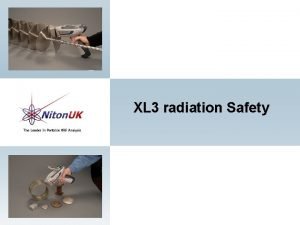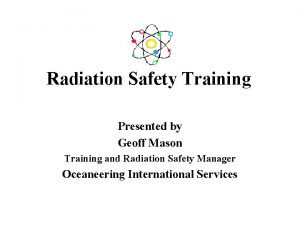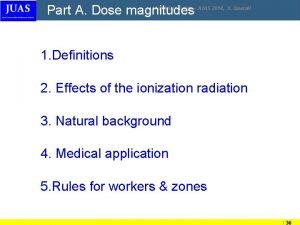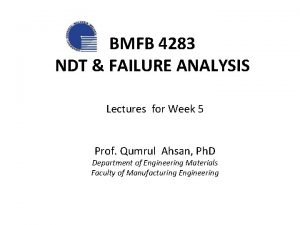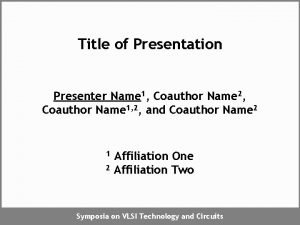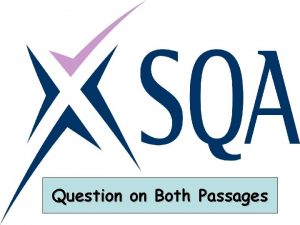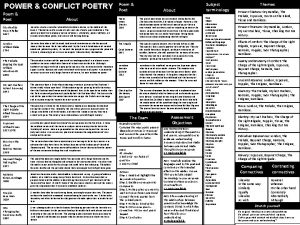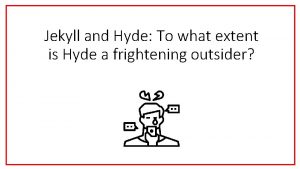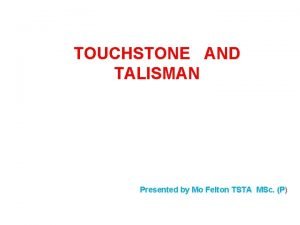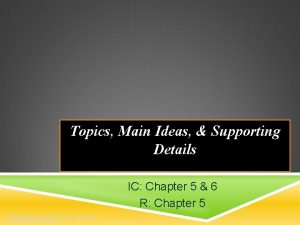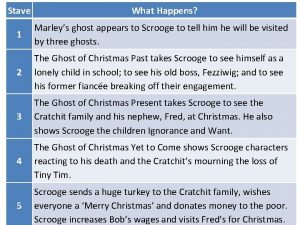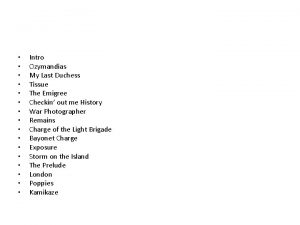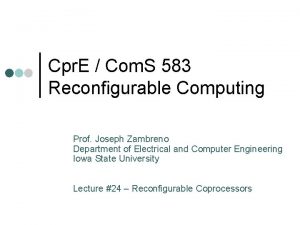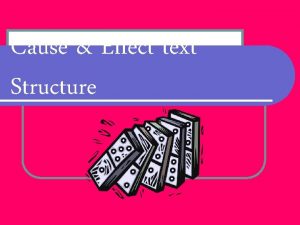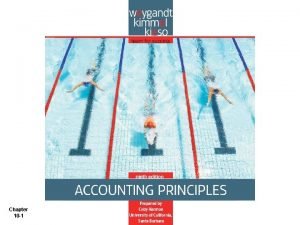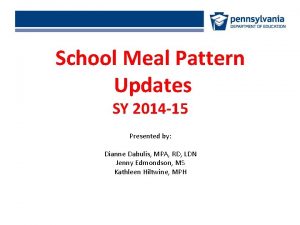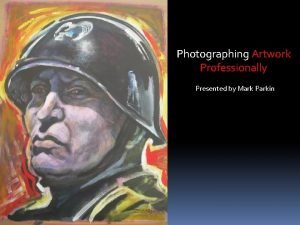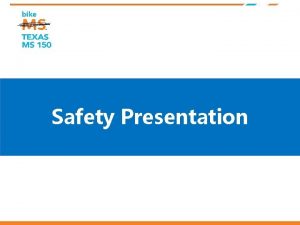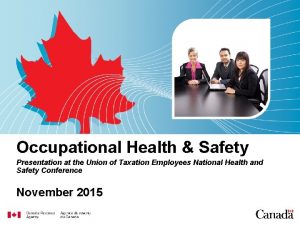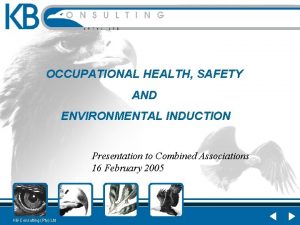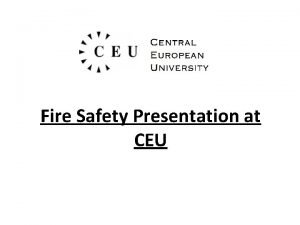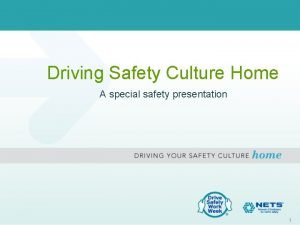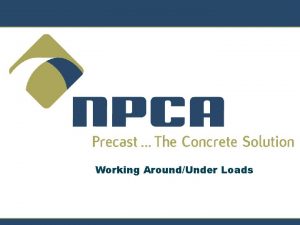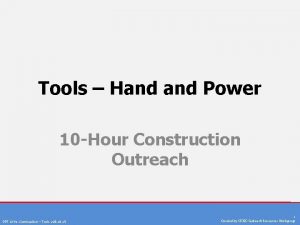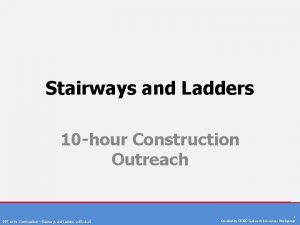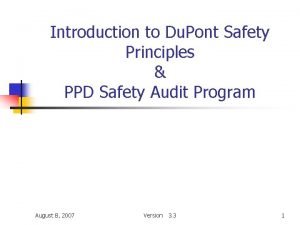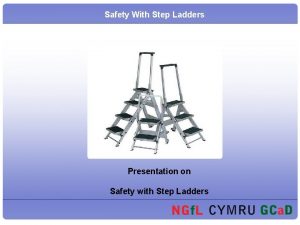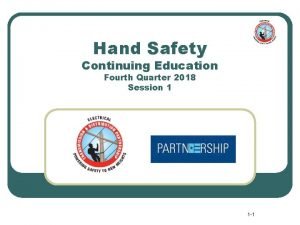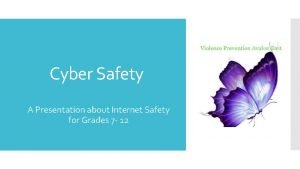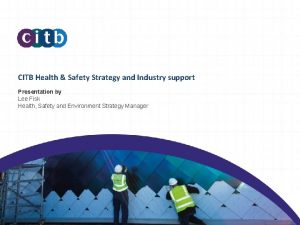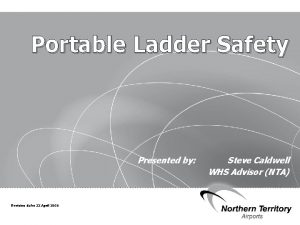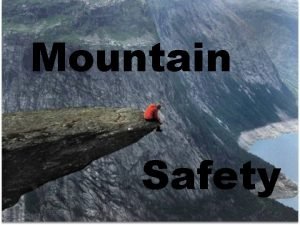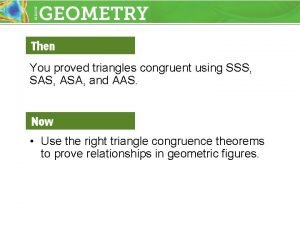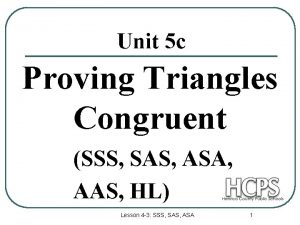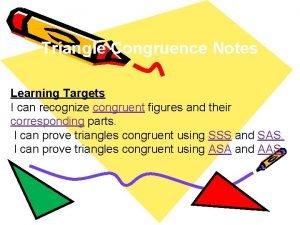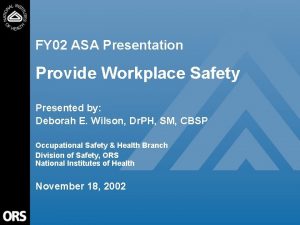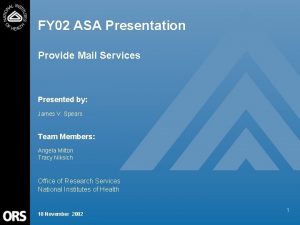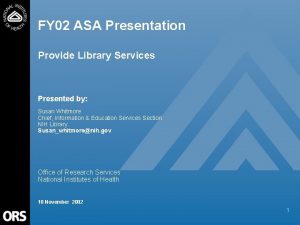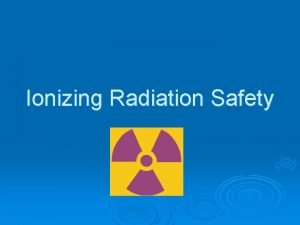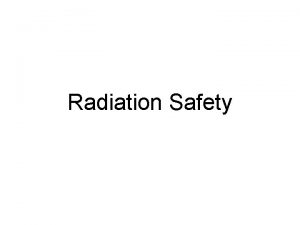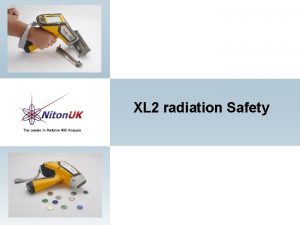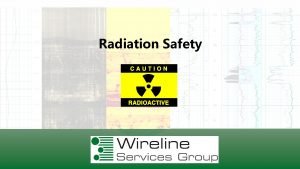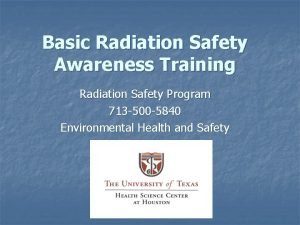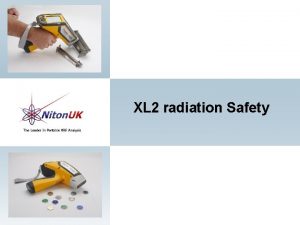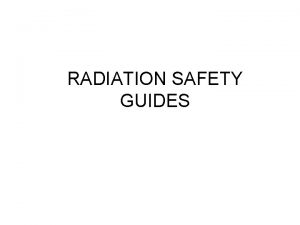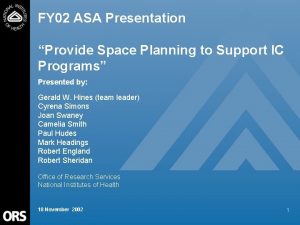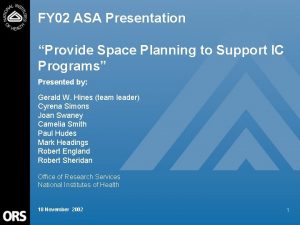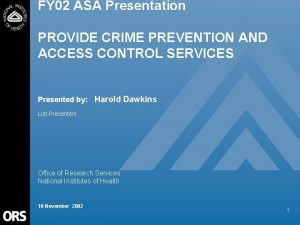FY 02 ASA Presentation Provide Radiation Safety Presented




































































- Slides: 68

FY 02 ASA Presentation Provide Radiation Safety Presented by: Bob Zoon, Team Leader Nancy Newman Cathy Ribaudo Israel Putnam Office of Research Services National Institutes of Health 18 November 2002 1

Table of Contents Main Presentation ASA Template ………………………………. 4 Customer Perspective………………. 5 Customer Segmentation ………………… 6 Customer Satisfaction…………………. 8 Internal Business Process Perspective…………………. 9 Service Group Block Diagram…………………………. . 11 Conclusions from Discrete Services Deployment Flowcharts………………. 12 Process Measures………………………………. . 13 Learning and Growth Perspective……………………. 17 Conclusions from Turnover, Sick Leave, Awards, EEO/ER/ADR Data……. . 18 Analysis of Readiness Conclusions………………………. 19 Financial Perspective……………………………. . 20 Unit Cost……………………………………… 21 Asset Utilization………………………………… 23, 25 Conclusions and Recommendations……………………. 26 Conclusions from FY 02 ASA. . ………………………… 27 Recommendations………………………………… 28 2

Table of Contents Appendices Page 2 of ASA Template Customer segments graphs (main presentation) Customer satisfaction graphs Block diagram (main presentation) Process maps Process measures graphs (main presentation) Learning and Growth graphs Analysis of Readiness Information Unit cost graphs (main presentation) Asset utilization graphs (main presentation) Any unique measures graphs (cost of ASA for DS 2) 3

4

Customer Perspective 5

Customer Segmentation 6

7

Customer Satisfaction • • • ORS Customer Scorecard used Response rate 15% Product/service satisfaction index 8. 75/10. 0 Customer service satisfaction index 8. 90/10. 0 Overwhelmingly positive feedback 8

Internal Business Process Perspective 9

Service Group Block Diagram 10

Conclusions from Discrete Services Deployment Flowcharts • • • Our Service Group completed 2 deployment flowcharts for 2 discrete services For technical assistance, flowchart showed that collaboration among Branch components, customer and the Radiation Safety Committee is essential. For radionuclides, flowchart showed smoothly functioning process for receipt and delivery of products to customers via contractor, with minimal problems. 11

Process Measures • Process measures for each discrete service • • DS 1: Enforcement actions per year DS 2: Vendor errors by month Enforcement actions decline over a five year period, indicating program success Vendor errors below 1. 2 % 12

DS 1: Enforcement Actions by Year 13

DS 1: Enforcement Actions 14

DS 2 : Vendor Errors per month 15

ERROR SEGMENTATION BY PROBLEM 16

Learning and Growth Perspective 17

Conclusions from Turnover, Sick Leave, Awards, EEO/ER/ADR Data • Our higher-than-average turnover rate puts us at a disadvantage • • Filling vacancies takes an inordinately long time Bringing new people up to speed takes time and effort • Use of sick leave is below ORS average • To be consistent with the rest of ORS, we need to consider more awards for employees. • The EEO data is misleading, i. e. , both cases were resolved by withdrawal of the pre-complaints. • The number of ER “cases” is misleading, as all 3 were, in fact, sequential actions for the same individual. 18

Analysis of Readiness Conclusions • We believe we will have the necessary resources to face the challenges of the future • • Plans for additional staffing via contract in response to major expansion of NIH facilities Diversion of existing staff to supporting research involving Positron-Emission Tomography (PET) Training of staff in cyclotron and PET technology Training of staff in high dose rate brachytherapy 19

Financial Perspective 20

Unit Cost Measures • • • DS 1: Membership fee of $5, 521. 74 per Authorized User per year (FY 03) DS 2: Per item fee of $76. 34 (Non-RAMOS) or $89. 06 (RAMOS) in FY 03 Both costs have increased due to increased cost of labor, contracts and higher costs for rent; expect continued increases in future 21

COST ANALYSIS TREND FOR DS 2 22

ASSET UTILIZATION (DS 1: provide technical assistance) • Maximum Input Capacity = FTE hours + overtime = 73, 600 + 390 = 73, 990 hours • Nonproductive Input = Standby + Duplication of Effort = 4, 726 + 460 = 5, 186 hours • Asset Utilization = (Maximum Input Capacity Nonproductive Input)/Maximum Input Capacity = (73, 990 - 5, 186)/73, 990 = 92. 9% 23

Asset Utilization Measures 24

ASSET UTILIZATION FOR DS 2 25

Conclusions and Recommendations 26

Conclusions from FY 02 ASA • • • Program, as operated, is highly successful at qualifying users to work with radioactivity and radiation safely. Customer satisfaction with program services and products, such as radioactive materials receipt and delivery, is very high. Given the necessity to maintain the capability to respond to emergencies (readiness) and the regulatory requirement for the program, there is little leeway for cost reduction. 27

Recommendations • Steps should be taken to reduce staff turnover • • Boost staff morale by increasing awards Encourage mentoring Continue expanding on-line services Incorporate decay into inventory records Eliminate the current radioactive material ordering system, “RAMOS” Decreasing package receiving contract by 1 FTE in response to decrease in packages received Consider reducing 1 administrative FTE (via attrition) 28

Appendices 29

30

Survey Distribution Number of Surveys Distributed Radiation Technical Services 594 Number of Surveys Returned Radiation Technical Services Response Rate 89 15% 31

Survey Respondents FY 02 Respondents by IC Note: Not all respondents answered this question. 32

Survey Respondents (cont. ) FY 02 Respondents by Location 33

Radar Chart FY 02 Product/Service Satisfaction Ratings Note: The rating scale ranges from 1 - 10 where “ 1” represents Unsatisfactory and “ 10” represents Outstanding. Refer to the Data Analysis and Graphing training for advice on interpreting these results. 34

Radar Chart FY 02 Customer Service Satisfaction Ratings Note: The rating scale ranges from 1 - 10 where “ 1” represents Unsatisfactory and “ 10” represents Outstanding. Refer to the Data Analysis and Graphing training for advice on interpreting these results. 35

Scatter Diagram FY 02 Customer Importance and Satisfaction Ratings Note: The Importance rating scale ranges from 1 - 10 where “ 1” represents Unimportant and “ 10” represents Important. The Satisfaction rating scale ranges from 1 - 10 where “ 1” represents Unsatisfactory and “ 10” represents Outstanding. 36

Scatter Diagram FY 02 Customer Importance and Satisfaction Ratings: A Closer Look Note: A smaller portion of the chart is shown so that the individual data points can be labeled. 37

What was done particularly well? • • • Problem handling is excellent. Health physicists have generally been creative and proactive in solving problems ranging from personnel issues to experimental design considerations. New on-line services add greatly to the convenience. Radiation safety training is very well-organized, easy to register, etc. Delivery of isotopes is very timely. Pickup of radioactive waste is also extremely prompt. Suggestions for improvements in radiation issues brought to our attention during monthly surveys. Handling of specific acute radiation safety problems that may arise. Responsiveness to requests for meetings to discuss radiation safety issues. Questions answered and new situations addressed promptly and completely. Response to questions concerning record keeping and safety. The RSB shows excellence in just about every aspect they are involved in. 1. Waste was picked up in a timely fashion. 2. Isotope was delivered in a timely fashion. I ship radioactive materials frequently. This has always been done very smoothly and with no problems. Also I receive Fed. Ex receipts etc. from Jamie West promptly after the shipment has been shipped. Also I have never met a person from the radiation safety branch or a contractor that wasn't very nice and helpful. Quality of isotopes and relatively low cost. I think the radiation branch has a difficult job that it does extremely well. The most outstanding feature of the radiation branch is its wonderful attitude where I have always felt they really try to help the scientists do their job. All the contract workers are just fantastic ranging from radiation pickup to routine surveys. The development of contract surveys (very reasonable price!) was brilliant and just what we needed to assist in the compliance of rules of operations. When there is a problem I can always count on the radiation office to help rather that be heavy handed in "blaming" (i. e, radioactive spill or other queries). 38

What was done particularly well? • • • (cont. ) Last year we had a summer guest researcher who wanted to use Cu-65 in the lab. We received excellent response and information from your staff when we were concerned about shielding, use, disposal, etc, as many lab personnel were concerned about exposure. And this year, in discussing this with our HP, we were happy to learn that allowing the use of such "unusual" isotopes is at our discretion. This year I told the guest researcher that he couldn't use Cu-65 under my authorization. Registration for the training classes. Always someone there to answer questions. Staff is very helpful. Prompt responses to inquiry. Response to query about safety of maintaining radioactive waste in the lab. Starting up a new lab, approving of new users, survey reviews. Waste pick up is very reliable. Training is conveniently scheduled and staff was very receptive and flexible about retaking of a test that someone in my group (a non-native speaker) didn't pass the first time. Thank you. Shipping discrepancies and information are dealt with efficiently. Requests for information are processed promptly and response is rapid. Willingness to meet and discuss questions with regard to Rad. Safety. Handling the logistics of closing laboratory down for renovations. I have seen significant overall improvement from placement of orders to receipt and delivery of isotopes. Both the NIH and the contractor personnel are very responsive to our needs. 39

What was done particularly well? (cont. ) • • • Our health physicist, Beth Reed, is always willing to stop by my lab or answer my questions over the phone. She has been quite helpful over the year I have been employed here at NIH. Our health physicist is outstanding. That was not always the case with former ones. I really like the online resources for changing people and locations under my supervision. The overall improvement over the years is much noticed. Helping us move our radioactivity during our move from 4 th to 5 th floors. Availability of the product. Efficient pre-review of new clinical research protocol. Samples are always rapidly cleared through RSO and delivered to us in a timely manner. RSO is very responsive to any questions etc. He is usually available. Communication from Radn Safety branch is clear and well distributed. I know that I can good information quickly in an emergency. All things considered, I think the Rad Branch does a pretty good job. My orders are always placed and arrive in a timely fashion. My health physicist is available when I have questions. My orders are delivered in a timely fashion. Additionally, any communication that I receive from the branch is usually to the point and worthwhile. We recently moved into a new lab and had a dedicated hot lab built. George Redmond was instrumental in many of the features of this space and how I equipped it. The end result is a lab available to 2 branches of an institute and no complaints from users (yet). The new web site is a great addition to the services. 40

What was done particularly well? (cont. ) • • Every problem we have had has been dealt with appropriately and efficiently. The services work. They stand out from many other services in this way. Pick up waste, web site Contractor surveys. Setting up new personnel with training and registration. Teaching, record keeping, contractor management, on-site problem solving. The emergency response and availability of the health physicist was very good. Waste management. Protocol processing. John Jacobus provides the training for DLM on a regular basis and manages to keep it interesting and to the point (especially since we do not handle primary sources vials, but radiation as it occurs in patient samples). I addition, he has been helpful in evaluating waste disposal for the service. 41

What needs to be improved? • • • I think that e-mail notices that high-light changes in rules would be useful. There sometimes seems to be some confusion with our procurement agent with ordering isotopes. Many times, during the past several yrs, I have received a phone call from Rad Safety Branch asking for an 88 -1 form after we already submitted one with the order. I don't know whether the confusion is with our procurement agent or the DELPRO system or ? Further increase in the use of internet or other computer-based ordering, tracking, user information based interface between radiation safety and is user group. RAD Safety User Training: Could be shortened. It is at times hard to get in touch with our health physicist. I think this is due to the recent turnover. At this point, I am not sure who was assigned as ours as they have not tried to contact me. Delivery time. Keep up the good work. Because of half life considerations, it would be great if partial 32 P orders are delivered instead of waiting for the arrival of the complete set. After an isotope has been ordered, if we have an expectation of delivery to the lab the following day, we are always anxious about: did the vendor ship the isotope, did the RSB receive the isotope, and are we going to obtain delivery to the lab that day? In other words, once an order is placed, the complex processing of isotope orders (purchasing agent, vendor, RSB processing, delivery to lab) puts us out of the loop. No good way for the investigator/user to track all of these steps, creating anxiety and "should I begin the experiment not knowing when the isotope will arrive on campus and into my lab? " Nothing. 42

What needs to be improved? (cont. ) • • • Feedback from Health Physicist if a problem occurs. Training refreshers-have we had them in a while? The delivery time of short T 1/2 radioisotopes for in-human use. Perhaps staffing more than one day a week at this facility. Coordination of RSC with other committees and PI to minimize delays. Ordering needs to be straightened out between radiation and purchasing. Only certain quantities of isotopes can be ordered through Ambis and not be rejected or needing an 88 form. But no one seems to know what they are. Given the important restrictions that need to be followed for handling isotope, I think Radn safety branch is doing a good job. I think that the record keeping/inventory controls on the Rad Safety end of things could be improved a bit. Every once in a while, my monthly reports are not accurate despite having sent paperwork into the Rad Saf Branch. Also, the manner/courteousy of the person handling the main phone line could be improved. When planning a survey/AU check, appointments made should be kept. If a time is set or mentioned by the AU, then it should be respected. I do not know which services we are billed for and how much, and which come from institutional funds. Having some more information and control over costs would be nice. Adding users to use/disposal sheets. Very little 43

What needs to be improved? (cont. ) • • Although deliveries were generally handled well, at least three times in the last two years we lost a set of experiments because samples were misplaced or not delivered. They do a great job and work very hard. My perception is that they need more FTE's to do their job. If so, they should get more resources. The quantity of short-lived isotopes held for a long time should not be calculated from the starting date - i. e. , decay should be calculated for the day of report. I would like to see one surveyor return each time - it is easier to work with the same person each time. 44

Other Comments • • • • Other than my brief comments above, I think the Rad Safety Branch does a very admirable and important job. Was satisfied with all aspects of the service received. Radiation Safety is a well organized, helpful branch of NIH. Generally the system works very well. Thanks for a job well done. You are one of the best divisions of the NIH. Overall, Radiation Safety does a great Job!!! Try to devise a system for the investigator/user to track the above steps. I think you are doing a great job. You have streamlined the record keeping. Allowing the securing of isotopes and waste in locked refrigerators/containers has pretty much eliminated the problem of keeping rooms locked during working hours. Your procedures have reduced the time I have to spend on compliance. Our use of isotope has been dramatically reduced by use of automated sequencing and other non-radioactive techniques, but we still have the need to use radioactivity, and we find all the new procedures to be very user-friendly. I'm quite satisfied with you. Lisa Coronado is a gem! Keep up the good work. I have had very light use of RSB services, and my comments should be weighed accordingly. By and large, Radiation Safety appears well organized, competent and helpful. Provide an online radiation safety course and certification. 45

46

47

DS 2: VENDOR ERRORS SEGMENTATION 48

PERKIN ELMER ERRORS 49

AMERSHAM ERRORS 50

ICN ERRORS 51

Learning and Growth Data • • All of the “Learning and Growth” data provided to us are incorrect: The percentages are based on 31 FTE’s and the Branch actually has 33 FTE’s. The “ 3” ER cases were, in fact, sequential actions for the same individual. The 2 EEO cases were both resolved and the precomplaints were withdrawn. 52

Service Group Turnover Rate (Oct 2001 - June 2002) Service Group Number 53

Average Hours of Sick Leave Used Average Hours (Oct 2001 - June 2002) Service Group Number 54

Average Number of Awards Received Average number (Oct 2001 - June 2002) Service Group Number 55

Average Number of EEO Complaints Average Number (Oct 2001 - June 2002) Service Group Number 56

Average Number of ER Cases Average Number (Oct 2001 - June 2002) Service Group Number 57

Average Number of ADR Cases Average Number (Oct 2001 - June 2002) Service Group Number 58

Learning and Growth Data Table 1 ADR case out of 31 employees About 16% employee turnover 3 ER cases out of 31 employees 2 EEO cases out of 31 employees About 1 award for every 3 employees About 4 days sick leave per employee 59

Readiness Questions • What are the right mix of skills and abilities needed to carry out the mission of this service group? Knowledge of the body of standardized, technical radiological survey and control practices and requirements such as those used in exposure minimization, contamination control, and decontamination. This knowledge should be applied on a regular basis to identify radiation deficiencies and enforce controls when applicable. Employees must be able demonstrate skill in monitoring activities of limited radiological complexity such as: preparation and decontamination of a therapy room, radioactive materials package and receipt, analysis of samples containing radioactive materials, radioactive waste handling, and inventory and leak test of sealed sources. The staff must be able to conduct technically sound radiological surveys in a variety of areas such as a research laboratory, contaminated patient room, animal care facility, unrestricted areas, radioactive materials packages, and radioactive waste areas. Knowledge of proper shielding necessary to protect against alpha, beta, and gamma radiation. Knowledge of equipment for detecting the presence of radioactivity; ability to read various standard radioactivity counters and accurately record the readings from detector equipment. The individual must be able to respond to emergencies and apply their skills in controlling potentially exposed personnel and activities in the event of a radioactive material spill and skin contamination. Staff must be able to access data from a computer database system, demonstrate knowledge of basic word processing, and use this information to create sound technical reports. The staff must be particularly adept at organizing, scheduling, and record keeping, and attentive to the absolute critical importance of executing his/her responsibilities accurately on schedule. All staff must have the ability to work in harmony with Vendors and Researchers using tact and diplomacy when dealing with problems. Staff must be able to use the NIH Administrative Database for the placing of consolidated orders to the Vendors on the RAMOS system. Staff must be able to properly package all forms of Hazardous Materials to comply with Department of Transportation (DOT) regulations and International Civil Aviation Organization Regulations. 60

• Will the service group have sufficient numbers of people, with the right skills and abilities to carry out its mission in the next three years? If not, what are the skills and abilities that will be needed, and how are you planning to obtain them (e. g. , contracting out, hiring)? - Based on present trends, yes. However, it should be noted that determining the direction of radioactive materials use in medical research is not known and could increase or decrease at anytime. If more staff is required, both contracting and hiring would be pursued. 61

• What are going to be the training needs of the employees and contractors employed in this service group in the next two to three years? -Contractor training is the responsibility of the contractor. Some government employees of this Service Group require training in the shipment of hazardous materials every two years, and DOT regulations every three years. Most staff are offered the opportunity to participate in the RSB Training & Travel plan to attend courses, both local and requiring travel, or to attend professional meetings, such as the Annual and Mid-Year meetings of the Health Physics Society. Training is a continual process and various training courses will be attended as needed. 62

• What will be the right tools or materials (e. g. , information, software applications, hardware, specialized equipment) needed to carry out the mission of this service group in the next three years? -This list would be too great to list here, everything required presently to perform these services will still be required in three years. As is evident in the recent ASA, anything that is planned for can change without warning and therefore would require Radiation Safety to cover those changes. This could include changes to vendors, nuclides, volume, inventories, software (especially for the ASA!), regulations, medical research, and staffing. • Does the service group have the right quantity of tools or materials needed to carry out its mission in the next three years? If not, what are the ones needed and how are you planning to obtain them? - See the answer to the previous question. 63

• What are the anticipated implications of not obtaining the right mix of skills and abilities, or tools and materials (e. g. , service disruption, inefficiencies, increased turnover of key personnel) in meeting service or mission expectations? Please explain. - Unknown at this time, most of the information for this question has been answered in the previous questions. If the proper mix of skills, abilities, tools, and materials are not provided this service group would not be able to provide the excellent customer service that has been provided for years. If this service group does not meet its service requirements the NIH would be in jeopardy of losing its ability to use radioactive materials in the Intramural Research Program. 64

DS 2: RAMOS COST SEGMENTATION 65

DS 2: NON-RAMOS COST SEGMENTATION 66

ASSET UTILIZATION FOR DS 2 67

COST OF MAINTAINING THIS INFORMATION FOR DS 2 68
 Radiation safety
Radiation safety Geoff mason
Geoff mason Radiation safety
Radiation safety Tungsten inclusion in rt film
Tungsten inclusion in rt film Kicker headlines
Kicker headlines Slide todoc.com
Slide todoc.com Duality of setting in jekyll and hyde
Duality of setting in jekyll and hyde Theme of love romeo and juliet
Theme of love romeo and juliet Which idea is presented in both passages?
Which idea is presented in both passages? Title of presenter
Title of presenter Ozymandias narrator
Ozymandias narrator Cognitive learning theory was presented by
Cognitive learning theory was presented by Hyde as a frightening outsider
Hyde as a frightening outsider Talisman presented
Talisman presented Topic main idea and supporting details examples
Topic main idea and supporting details examples Comparing kamikaze and the prelude
Comparing kamikaze and the prelude Design process
Design process Bob cratchit quotes
Bob cratchit quotes Procedure text
Procedure text Introduction to conic sections
Introduction to conic sections My last duchess and ozymandias
My last duchess and ozymandias Prism is presented with
Prism is presented with This text structures can be confused with cause and effect
This text structures can be confused with cause and effect Views technical drawing
Views technical drawing How are the events in the text presented
How are the events in the text presented Proudly presented to
Proudly presented to Macbeth act 5 scene 4
Macbeth act 5 scene 4 Lesson in macbeth
Lesson in macbeth One characteristic of plant assets is that they are:
One characteristic of plant assets is that they are: As presented below
As presented below Types of polygons
Types of polygons Krispy kreme vs dunkin donuts
Krispy kreme vs dunkin donuts Young and dyslexic past paper
Young and dyslexic past paper Presented sy
Presented sy The kitchen presented by
The kitchen presented by Professionally presented
Professionally presented Caltech bursar
Caltech bursar The element of music that organizes movement in time is:
The element of music that organizes movement in time is: How it's made presented by
How it's made presented by Plant assets natural resources and intangible assets中文
Plant assets natural resources and intangible assets中文 Occipital brow presentation
Occipital brow presentation Leopold maneuver
Leopold maneuver Safety presentation topics
Safety presentation topics Occupational health and safety presentation
Occupational health and safety presentation Health and safety induction presentation
Health and safety induction presentation Fire safety presentation
Fire safety presentation Driving safety presentation
Driving safety presentation Suspended load definition
Suspended load definition Hand and power tool safety ppt
Hand and power tool safety ppt All wheel drive tire rotation
All wheel drive tire rotation Double cleated ladder
Double cleated ladder Dupont safety presentation
Dupont safety presentation Safety leadership presentation
Safety leadership presentation Ladder safety powerpoint
Ladder safety powerpoint Hand safety presentation 2018
Hand safety presentation 2018 Cyber safety presentation
Cyber safety presentation Citb cdm wizard
Citb cdm wizard Ladder risk assessment checklist
Ladder risk assessment checklist Worst place for midges in scotland
Worst place for midges in scotland Winter driving safety presentation
Winter driving safety presentation Safety depth formula in ecdis
Safety depth formula in ecdis Safety care training
Safety care training Personal safety vs process safety
Personal safety vs process safety Ind safety report
Ind safety report Basic safety orientation
Basic safety orientation Construction site safety orientation
Construction site safety orientation Right triangle congruence
Right triangle congruence Unit 5 lesson 2 triangle congruence by sss and sas
Unit 5 lesson 2 triangle congruence by sss and sas Ssa theorem
Ssa theorem
